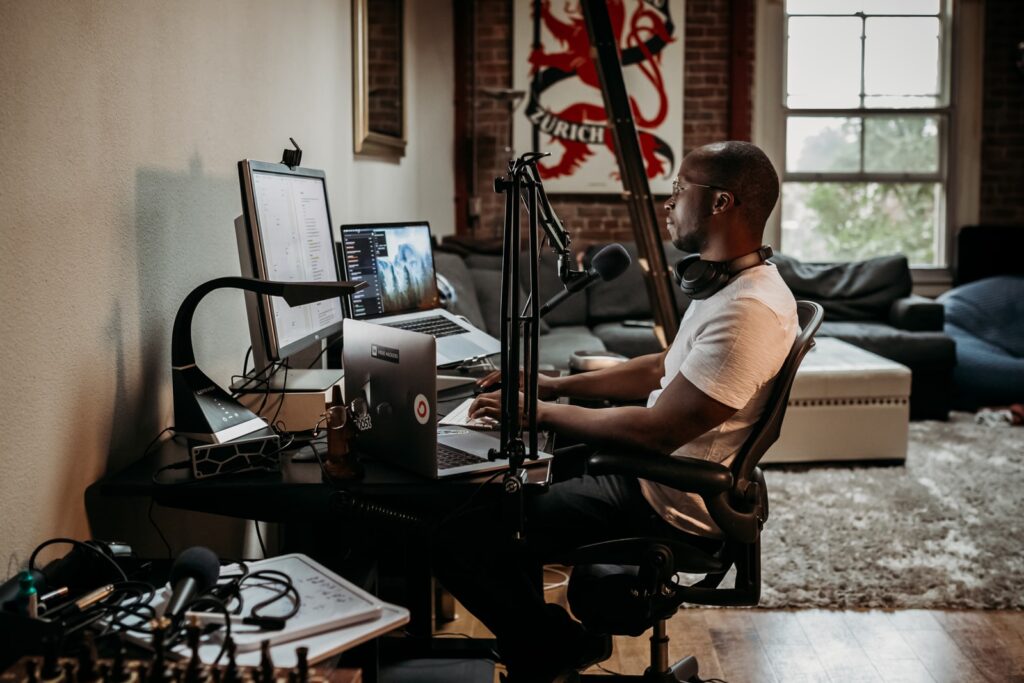Running a podcast is a lot of work. Trust someone who recorded over 100 Alt Marketing School episodes.
After growing your podcast organically, you’ll reach a natural tipping point where the natural progression is, well, to monetise. Yet, before I illustrate three ways to make money through a podcast, let me warn you.
If you are starting a podcast with the sole idea of monetising it, you won’t go far at all. Why? Because you need to first remember that what you are trading, before anything else, is time.
What your audience is giving you first and foremost is their time. Without that time, those listeners, you do not have a show in the first place.
I am reiterating this because until you have a clear USP, a great show idea, and a fantastic structure you can follow, you will struggle to create a show that stands out from the crowd.
There are a few cases where you may start a sponsored podcast – which means you’ll already have a deal before you even begin your show. However, your podcast needs to perform for you to be able to keep up with the partnership in itself.
Your monetising goals
It’s time to lay out your financial podcast goals. You may read this guide and think: “Sod it. I just want to bring awareness to my brand.” That is totally fine. As long as your listeners grow, your audience is engaged, and you can see it becoming a key asset of your brand, I will be your biggest cheerleader. If you want to monetise your show, ask the right questions.- Are you looking to generate direct income from online sales, for example?
- Are you playing the long game and looking for leads toward future sales?
- Perhaps you want to promote your brand without any measurable financial benefit?
Monetise your podcast via sponsorships and ads
One of the easiest ways to monetise a podcast is through ads and sponsorships. Let me talk about ads first. Ads can either be native or non-native. Native ads are designed to feel like a natural part of the show. Non-native ads are obvious commercial breaks. The latter generally only works if your audience is large enough to interest advertisers. Regardless of the type of ads, you’ll probably be looking at having to do a lot of audience research to “sell” your audience to the right advertisers. Anything from your audience’s interests to demographics and location is critical for potential advertisers. You can use your statistics here to find a good fit. If the product targets a different age group or location from most of your listeners, the advertisement won’t work, and the advertiser won’t stick around long. A lot more brands these days are looking to create their own podcast or flat-out sponsor an entire season or even a whole show. This in itself has its pros and cons. Sponsored shows created as a partnership with a brand are a double-edged sword as they may limit your creativity – it also means that if your sponsor decides to discontinue the partnership, the show may be over. You can also look for sponsors after your show is aired and have one to three companies on rotation for native-style ads throughout your episodes. One more option to monetise your podcast is to join platforms like Open Acast that allow you to sponsor your podcasts through their marketplace. This could save a lot of obvious back-and-forth with multiple companies.Exclusive podcast content and subscriptions
A common approach with creatives to monetise a podcast is asking your audience to pay you directly for your content. Take Patreon, a subscription service that can provide content producers with a steady and predictable income. For their monthly donations, listeners receive special rewards like merchandise or access to unique content. This model has allowed many people to quit their jobs and become full-time podcasters and can work for creatives who may not be looking to align with a brand or company in particular. One of the giant red flags in this model is the rewards you can offer through your subscription. Before exploring this option, map out the amount of work this exclusive content require.Brand cross-promotion
Many podcasters have been using the reactive approach to monetising their podcast, through which they started a podcast and subsequently used it to promote their own courses, services, or even book launches – or platform BCast specialises in this type of cross-promotion. This has been the primary model we have used for various content marketing avenues. We still do this to some extent, as it works well with straightforward calls to action. Podcasters such as Tim Ferris, Lewis Howes and entrepreneur Marie Forleo have done this in a multitude of ways before.Take time to see what works
I love looking at the most successful episodes, as it helps me understand what people are looking for from our show. Some services track not just downloads but how far into individual episodes listeners made it. We use BCast to host our podcast – it’s easy to distribute and upload, yet, the statistics it provides are precious. Knowing your audience will help you stay on topic and engaged. Statistics tell you how many people downloaded your show, where they’re from, and what app or distribution platform they’re using.- How large is your audience?
- Is it growing? Shrinking?
- In what countries?
- On what devices?
- Did specific topics or guests lead to a spike in traffic?
Putting it all together
If you want a successful, profitable podcast, you need to know your audience and what they want. Start with imaginary listeners, then use social media and statistics to get a real sense of what they value. Provide that value professionally and consistently. From there, use loyalty to your brand to reach your goals. I look over the broader picture with the Alt Marketing podcast every quarter. By taking the time to look at our audience’s behaviour, I could genuinely head back to the critical goal of our podcast, which falls into the category of brand awareness and discoverability. Once I knew that I could then ensure the podcast would attract similar people to our current audience and have the right mix of content to keep listeners coming back. Remember: a good podcast has a symbiotic relationship with its audience. Communities emerge around your brand, and that’s a tremendously valuable asset for any business.Looking for help marketing your podcast effectively?
Check out our positive impact marketing fundamentals course, in which you’ll learn how telling your stories through content (including podcast) can help you grow your brand.Want more? Here's your invitation from the school ⤵️
We don’t teach you how to do more. We teach you how to do it better.
You don’t need more hacks. You need smarter foundations, better systems, and clarity that cuts through the noise.You got into this to make a difference. Let’s help you do that, with strategy and a whole lotta heart.
➡️ Find out how we can help via our all-access pass.



